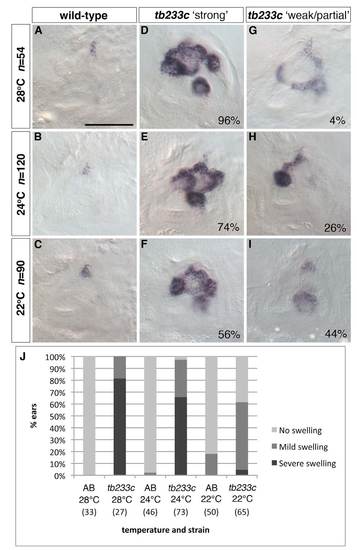Fig. S6
- ID
- ZDB-FIG-131213-9
- Publication
- Geng et al., 2013 - Semicircular canal morphogenesis in the zebrafish inner ear requires the function of gpr126 (lauscher), an adhesion class G protein-coupled receptor gene
- Other Figures
- All Figure Page
- Back to All Figure Page
|
Incubation of lautb233c mutants at a lower temperature throughout the fusion period has a rescuing effect on otic versican expression and projection fusion. (A-I) Expression of vcanb in 4dpf wild-type (A-C), and tb233c (B-I) embryos, incubated at 28°C (A,D,G), 24°C (B,E,H) and 22°C (C,F,I). Embryos were initially grown for 24 hours at 28°C. In wild-type embryos, vcanb expression is down-regulated in the fused pillars; staining only remains in the dorsolateral septum (DLS) (A-C). Mutant embryos retain strong vcanb expression in the unfused projections (D-F). Some mutant embryos show weaker expression (G) or partial expression where there are fused and unfused pillars in the same ear (H,I). The proportion of embryos showing decreased vcanb expression and rescue of fusion increases with a decrease in temperature. Percentages for each phenotypic class are shown on the panels; N numbers (number of mutant ears analysed) are shown in the boxes at the left. (J) Graphical representation of ear swelling data for wild-type and mutant embryos grown at different temperatures. The rescue of fusion in one or more pillars results in a decrease of swelling in the ear. Embryos grown at lower temperatures have reduced swelling in the ear. N numbers (number of mutant ears analysed) are shown in parentheses. |

